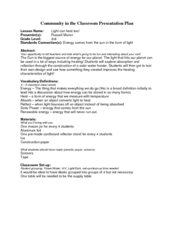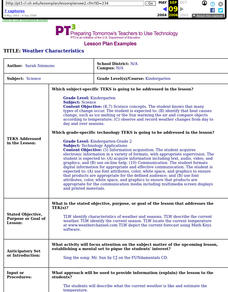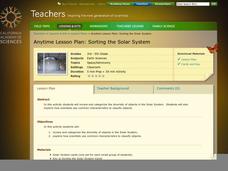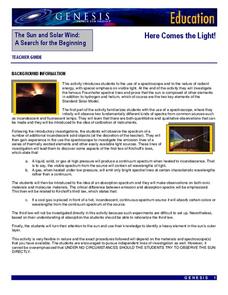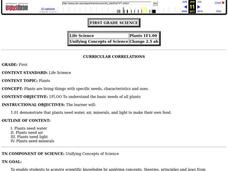Curated OER
Tracking and Tracing Sunspots
Young scholars examine sunspots. In this sunspot lesson, students use applets to investigate the movement of sunspots. Young scholars research sunspots and evaluate the rotation of the sun. Lesson references outside resources not...
Curated OER
Light Can Heat Too!
Third graders explore absorption and reflection of light energy. For this solar energy lesson, 3rd graders explore how light energy transfers to heat energy through the construction of a solar water heater. Students will discuss and...
Curated OER
Weather Characteristics
Students identify characteristics of weather and seasons, describe the current weather, identify the current season, and locate the current temperature at www.weatherchannel.com. They also depict the current forecast using Math Keys...
Curated OER
Solar Eclipse Presentation
For this solar eclipse worksheet, students fill in the blanks with terms about the sun and its characteristics and the process of a solar eclipse.
Curated OER
How can my breakfast help the birds?
Sixth graders design farms with a bird's habitat in mind. In this farm lesson plan, 6th graders research how sun grown coffee destroys a bird habitat, and then they make their own farm with a bird's habitat being preserved. They then...
Curated OER
Characteristics of Materials
Learners describe and compare common properties of various classroom materials. In this science/matter lesson, students observe common classroom items and the materials they are made of to complete a list of common properties.
Curated OER
Notes: Characteristics of Stars
Students investigate stars and the solar system by completing a worksheet. For this space science lesson, students complete a fill in the blank worksheet based on the stars and components of the cosmos.
Curated OER
How Big Is That Star?
Aspiring astronomers study stars. They compare stars and explain the relationship between radius, mass, and diameter. By creating a star simulation, they discover how a binary star system's orbit can cause changes in the observed...
Curated OER
The Solar System - A Review
Students analyze their knowledge about the solar system. In this solar system review lesson, students look at a picture of the solar system on the SMART Board, name them in order, and are able to identify the sun as the center. They...
California Academy of Science
Sorting the Solar System
Scientists are always sorting and classifying objects based on their characteristics. In a hands-on learning activity, young space explorers work together to categorize solar system cards based on their properties. It is up to the young...
Core Knowledge Foundation
Weather or Not, Seasons Change
Embark on a year long investigation of the seasons with this 10-lesson earth science unit. After being introduced to different types of weather and the tools used to measure it, young scientists perform fun hands-on activities that teach...
University of Wisconsin
Noting Notable Features for Rain Gardens
Eight groups in your class are each responsible for a different aspect of surveying the campus for a suitable rain garden location. Features to consider include water flow, topography, sun/shade patterns, land surface, vegetation,...
NASA
Here Comes the Light!
Look beyond the light! An engaging activity introduces young scholars to the application of a spectroscope. The lesson is the fifth in a series of six and focuses on the analysis of the elements of the sun.
Curated OER
Modeling the Solar System
Young scholars build a scaled model of the solar system. In this space science lesson, students arrange them according to their distances from the sun. They analyze each planet's unique features such as density and relative gravity.
University of Colorado
Space Travel Guide
Neptune takes 164.8 Earth years to travel around the sun. In the fifth of 22 lessons, young scientists create a travel guide to a planet in our solar system. They provide tips for others on what to bring, what they see, and their...
Columbus City Schools
Experiencing Eclipses
Don't be caught in the dark! Young scientists investigate the causes of both solar and lunar eclipses using an interactive to help them understand the development of an eclipse over time. They then research facts and characteristics of...
American Museum of Natural History
What is Marine Biology?
A marine environment covers the majority of the earth but is arguably the least understood. Teach young scientists about the characteristics of oceans and ocean species using an interactive online lesson. The in-person or remote learning...
Curated OER
Plants
First graders explore the specific needs, characteristics, and uses of plants. They discuss the needs of plants as they grow. Students observe plants in various settings as they grow and note the changes they see.
Curated OER
Selling the Stars
Students create a travel brochure, poster, and presentation to encourage others to visit a star. In this stellar characteristics lesson, students research a star type based on its life-cycle. They create a travel campaign to convince...
Curated OER
Sun and Shade
Young scholars explore the ways that plants adapt to their environments. They examine plants that thrive in the shade, versus plants that thrive in direct sunlight. Special attention is devoted to the shape of leaves on respective sun...
Curated OER
Optional Laboratory: Comparing Soil Temperatures In Sun and Shade
Young scholars work together to test the temperatures of different soils in shade and sun. They make their own hypothesis before beginning the experiment. They record their data and discuss as a class.
Las Cumbres Observatory
Agent Exoplanet
Not everything revolves around the sun! Believe it or not, there are planets, called exoplanets, that orbit stars other than our sun. Learners use an interactive online resource to research several of these planets. They learn about the...
Curated OER
The Story of the Solar System
There is more to the solar system than the typical study of the sun and planets. Launch a study of asteroids, meteoroids, and comets by watching the video The Story of the Solar System, available for purchase through this resource on the...
Mr. E. Science
Stars, Galaxies and the Universe
It takes 225 million years for our sun to travel around the galaxy. The presentation covers astronomical units, light years, telescopes, types of stars, the life cycle of a star, and types of galaxies. This is the last lesson in a...



